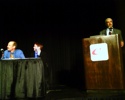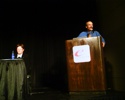Malcolm Brown, Director of Academic Computing at Dartmouth, Salid Ganjalizadeh, Assistant Director for Instructional Technology at Catholic University, Leslie Hitch, Director, Academic Technology Services at Northeastern University, Christine McMahon, Manager, Advanced Technology at Saint Louis University, Pablo Molina, CIO Information Systems at Georgetown University, John Moses, Director, Technology Planning, Biological Sciences at the University of Chicago, and Art St. George, Manager, Advanced Communications Technologies presented. The session was dedicated to the memory of Howard Strauss – his friends and family were in the first row.
Pablo began the session. He was the chair of the Evolving Technologies Committee. The five other presenters all wrote white papers to participate in today’s session. The point was to identify and investigate emerging technologies, and to make us thirsty not only for happy hour but to learn more about technologies presented today.
Pablo mentioned an article in the EDUCAUSE Review that we all received for the conference, “Pioneering New Territory and New Technologies“.
Art St. George from the University of New Mexico spoke next. He began with a quote from Stuart Brand, “Once a new technology rolls over you, if you’re not part of the steamroller, you’re part of the road.â€Â Wireless is a steamroller – it is being adopted quickly everywhere. Drexel, Wake Forest and Notre Dame are leading the way. Wireless is not a fad, and while it’s not a complete substitute for researchers on the wired network, it is embraced quickly as the network.
Saiid presented next on course management tools. They have become enterprise applications over the last few years. edu-tools has a comparison of the different CMS applications – they are largely the same.
Open source systems lack documentation and formal support. Saiid recommends having multiple CMS systems on campus until the open source applications are more mature, integrated and accepted by the faculty.
Leslie presented next about cell phones and mobile phones. MyFoodService.com will take your photograph of your food for $10/month and send you a caloric evaluation (I couldn’t find the site – perhaps that was a joke?).
Challenges to cell phone use include aging eyesight, adoption, and authentication. But can the cell phone replace some applications? Should we partner with vendors over cell services and form function, and can we use students to make our case?
Malcolm Brown talked about the rapid pace that has come with Web 2.0 applications. They are a broad range of applications that are expanding so rapidly it is being likened to the .com boom. Example categories of Web 2.0 functionality include Office alternatives, web desktop (UOS, IOS), social hangout, shared content depositories, VoIP, E-mail and Mapping.
Office players include: Jotsopt, iRows, DabbleDB, Thinkfree, NumSum and Thumbstacks. Google also has many competitors. Tagging and collaboration are finding their way into these applications.
These applications are gaining in relevance, and the OpenDocument Foundation is working towards an XML-based document standard that may bring an end to Microsoft’s dominance.
Christine presented on Vortals – vertical portals that can be used for research services and more. How do you build tools that reach the researchers desktop that helps them comply with compliance rules? The model is an onion, with the research community on the outside, with investigators next, followed by research administrators and collaborative information. Information from Banner is downloaded to the portal so they can build routing tables that allow researchers to push proposals through the appropriate areas on campus.
Question: how are some of these devices adding to or helping close the digital divide? Cell phone ownership worldwide has increased exponentially. Cell phones are perhaps the most ubiquitous device today.
Technorati Tags: EDUCAUSE2006, Web 2.0, technology




